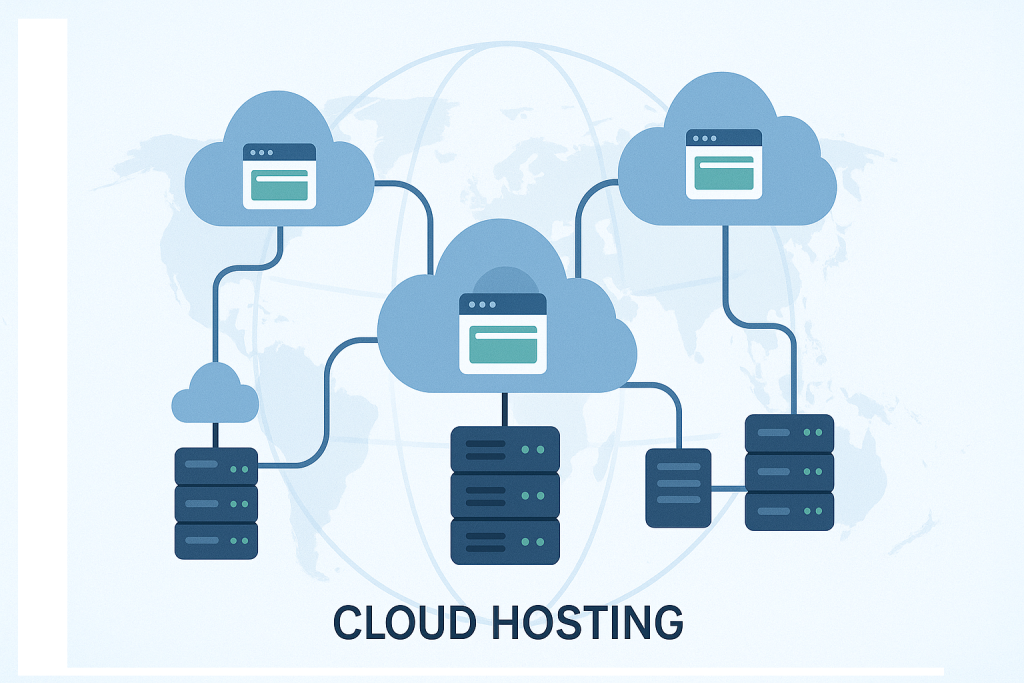In the modern digital landscape, the demands placed on websites have evolved far beyond the capabilities of traditional single-server hosting. Whether you operate a rapidly expanding e-commerce platform, a global SaaS application, or a high-traffic media portal, your hosting solution must be dynamic, resilient, and instantly scalable. This is where Cloud Hosting emerges as the definitive future of web infrastructure.
Unlike conventional hosting models that rely on a single, fixed machine, cloud hosting distributes your website’s resources across a vast network of interconnected servers. This fundamentally changes the game, offering unprecedented reliability, flexibility, and performance that is essential for businesses in 2025.
This comprehensive guide will provide a deep dive into the technology, benefits, challenges, and critical decision points of choosing a Cloud Hosting solution, ensuring you have the strategic knowledge required to scale your digital presence.
Part 1: Deconstructing Cloud Hosting (The Technology Behind the Cloud)
To truly understand the power of cloud hosting, it is necessary to move past the simple term and grasp the underlying architecture that makes it unique.
What is Cloud Hosting? The Networked Approach
Cloud Hosting utilizes a cluster of physical and virtualized servers, often referred to as a cloud fabric or cloud infrastructure, to host a client’s website. This network is typically housed in geographically diverse data centers.
- The Shared Dilemma (Recap): In Shared or VPS hosting, if the single physical server fails, your website goes down.
- The Cloud Solution: In cloud hosting, your website data and application environment are replicated across multiple storage nodes and servers. If one server experiences a hardware failure or maintenance issue, another server (or “node”) within the cluster immediately takes over the load. This mechanism is known as failover and ensures High Availability.
How Cloud Hosting Works Behind the Scenes
The seamless operation of cloud hosting relies on three core components:
- Virtualization Layer: Similar to VPS, powerful virtualization technology (like KVM or proprietary hypervisors) is used, but here, the resources are pooled from the entire cluster, not just one machine.
- Load Balancing: A Load Balancer sits at the front end, acting as the traffic cop. It automatically directs incoming web traffic across the multiple servers in the cluster, preventing any single server from becoming overloaded. This optimization ensures uniform speed and reliability across all users.
- Storage Area Network (SAN): Your website’s data and files are not stored on a single hard drive. Instead, they reside on a robust Storage Area Network (SAN). The SAN ensures that all servers in the cloud cluster have instant, parallel access to your data, which is essential for rapid scaling and redundancy.
Part 2: The Unmatched Advantages of Cloud Infrastructure
The core benefits of cloud hosting revolve around its dynamic nature, solving the most common limitations of traditional hosting models.
1. Unprecedented Scalability (Elasticity)
This is the flagship feature of the cloud. Scalability refers to the ability to instantly scale resources up or down based on demand, a feature often referred to as elasticity:
- Handling Spikes: If your e-commerce site experiences a sudden viral surge of traffic (e.g., Black Friday sales), the cloud infrastructure automatically assigns more CPU and RAM from the cluster to your site, preventing crashes or slowdowns.
- Cost Efficiency: Conversely, during low-traffic periods (e.g., late night), the resources can be scaled down, reducing your running costs. This dynamic resource allocation prevents you from paying for power you don’t use.
2. Maximum Uptime and Reliability (Redundancy)
The cloud architecture is built to withstand failure:
- No Single Point of Failure: Since your environment is distributed across many nodes, the failure of one physical server is instantly compensated for by the available capacity of the rest of the network. This results in typical uptime guarantees of 99.99% or higher.
- Instant Failover: If a server fails, your environment is automatically rebooted on a healthy server in the cluster, often with zero noticeable downtime to the end-user.
3. Faster Global Performance (Low Latency)
Many premium cloud providers leverage a global network of data centers, leading to significant speed improvements:
- Geographic Proximity: By hosting your application on a server physically closer to your target audience (e.g., a data center in Singapore for an Asian audience), the cloud reduces latency, leading to faster initial load times.
- Content Delivery Networks (CDNs): Many cloud solutions integrate seamlessly with, or include, their own global CDNs, caching your content closer to your users for near-instant delivery.
4. Cost Efficiency with Usage-Based Billing
Unlike the fixed, flat-rate monthly fees of shared and dedicated hosting, cloud pricing adopts a utility model:
- Pay-as-You-Go: You are billed only for the resources (CPU hours, RAM usage, storage size, bandwidth consumed) that your application actually utilizes. This makes cloud hosting highly efficient, particularly for startups with unpredictable growth.
Part 3: Navigating the Complexities and Challenges of Cloud Hosting
While the advantages are compelling, cloud hosting is not without its challenges. For businesses making the transition, recognizing these potential pitfalls is vital.
1. Cost Management and “Bill Shock”
The pay-as-you-go model, while flexible, can lead to unpredictable expenses:
- Traffic Spikes: If a traffic spike causes your auto-scaling features to activate, you will suddenly be billed for the extra resources. Without proper monitoring and resource capping, this can lead to “bill shock”—a surprisingly large invoice.
- Hidden Fees: Cloud providers often charge separate fees for network egress (data leaving the network), specific managed services (databases, Kubernetes), and storage snapshots, which can quickly inflate the basic compute cost.
2. The Learning Curve and Operational Complexity
Cloud hosting platforms (especially the Hyperscalers like AWS, GCP, and Azure) are vast ecosystems offering hundreds of specialized services:
- Steeper Learning Curve: Setting up, configuring, and optimizing a cloud environment requires far more technical knowledge than simply installing WordPress on a cPanel-based VPS.
- Need for DevOps Skills: Successful management of cloud resources often requires specialized DevOps skills for configuration as code, advanced monitoring, and cost optimization. This is why Managed Cloud Hosting solutions (like Cloudways or some SiteGround plans) are popular, as they abstract away the complexity.
3. Vendor Lock-in and Migration Difficulty
Once you deeply integrate your application with a specific cloud provider’s proprietary services (e.g., AWS Lambda or Azure Functions), migrating the entire environment to a different cloud provider becomes extremely complex, time-consuming, and expensive. This is known as Vendor Lock-in.
Part 4: Who Should Choose Cloud Hosting and When to Upgrade
The dynamic nature of the cloud makes it the ideal choice for specific business profiles and operational needs.
Ideal Cloud Hosting Candidates
- E-commerce Stores with Seasonal Traffic: Businesses that see massive, predictable traffic spikes (holidays, product launches) need cloud elasticity to handle the load and scale down afterward.
- SaaS Platforms and Mobile Apps: Applications requiring global delivery, low latency, and the ability to scale processing power instantly to meet growing user bases.
- Agencies and Developers: Those building complex, modern, containerized applications (using Docker or Kubernetes) benefit from the native developer tools offered by cloud platforms.
- Media and Streaming Services: Sites that deliver large volumes of rich content (high-resolution images, video) benefit from distributed storage and high-speed bandwidth guarantees.
When to Upgrade from VPS to Cloud
The decision to move from a fixed-resource VPS environment to a dynamic cloud environment should be based on operational need, not just cost:
- Unpredictable Traffic: Your monthly traffic is highly variable (e.g., 20,000 to 200,000 visitors in a single week).
- Global User Base: You need to serve content and applications efficiently across multiple geographic regions to reduce user-facing latency.
- Downtime is Catastrophic: Your business cannot tolerate any service interruption (i.e., every minute of downtime costs significant revenue).
- Requirement for Modern Architectures: You need to deploy container-based applications (microservices) using technologies like Kubernetes.
Conclusion: The Future is Dynamic
Cloud Hosting is no longer just an alternative; it is quickly becoming the baseline expectation for modern, professional web hosting. It provides the scalability, resilience, and speed required to compete in the fast-moving digital economy of 2025.
While the technical complexity and cost management require a thoughtful approach, the ability to instantly adapt to traffic demands and guarantee near-perfect uptime offers a strategic advantage that traditional fixed-server models simply cannot match. For any business that is growing rapidly, targeting a global audience, or running a mission-critical application, the transition to cloud hosting is a necessary step towards future-proofing your operations.



